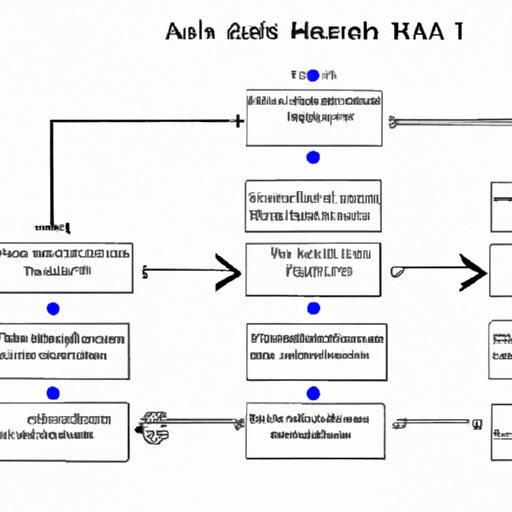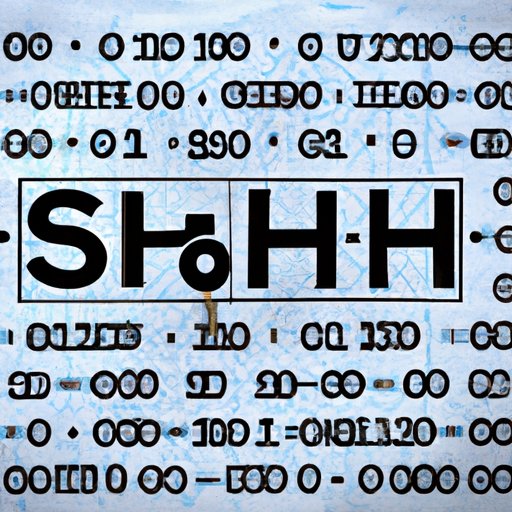Introduction: What is a Hash Crypto?
Hash cryptography, also known as cryptographic hashing, is a security technique that uses a mathematical algorithm to transform data into a unique string of characters. This output, or “hash”, is used to verify the integrity of the data. In other words, it is used to ensure that the data has not been changed in any way since it was first created.

A. Definition of Hash Cryptography
Hash cryptography is a type of cryptography that takes an input of any length and produces a fixed-length output. This output is known as a “hash” and is usually represented as a hexadecimal number. The hash is generated using a one-way cryptographic algorithm, meaning that it is impossible to go back from the hash to the original data. This makes hashes ideal for verifying the integrity of data without actually having to store the data itself.
B. Why Use Hash Cryptography?
The main purpose of hash cryptography is to ensure the integrity of data. It can be used to detect changes in data that have occurred over time, such as unauthorized modifications made by an attacker. Hash cryptography can also be used to verify the authenticity of data, such as ensuring that a file being downloaded is the same one that was originally uploaded. Finally, hash cryptography can also be used to generate passwords that are both secure and difficult to guess.
Overview of How Hash Cryptography Works

A. The Process of Generating and Verifying Hashes
The process of generating a hash begins with the input of data. This data is then run through a cryptographic algorithm, which produces a unique output known as a “hash”. The hash is then stored in a database or other storage medium. To verify the integrity of the data, the same algorithm is used to generate a new hash from the stored data. If the two hashes match, then it can be assumed that the data has not been modified.
B. Security Benefits of Using Hash Cryptography
The primary benefit of using hash cryptography is that it provides a secure way to verify the integrity of data without having to store the actual data itself. This prevents attackers from accessing the data in order to make unauthorized modifications. Additionally, it helps to prevent malicious actors from making changes to the data in transit. Finally, since the hashes are generated using a one-way cryptographic algorithm, it is virtually impossible to reverse engineer the data from the hash.

Common Uses for Hash Cryptography
A. Password Storage
One of the most common uses for hash cryptography is to securely store passwords. Instead of storing the passwords in plain text, they are instead converted into a hash using a cryptographic algorithm. This ensures that even if the password database is compromised, the passwords themselves remain secure.
B. Digital Signatures
Digital signatures use hash cryptography to ensure the authenticity of a digital document. A hash is generated from the document and then signed with a private key. When the document is received, the signature can be verified by generating a new hash from the document and comparing it to the signature. If the two hashes match, then it can be assumed that the document has not been modified since it was signed.
C. Encryption
Hash cryptography can also be used in conjunction with encryption to further enhance the security of data. By generating a hash of the encrypted data, it becomes much more difficult for an attacker to modify the data without being detected. This is because the attacker would need to know the encryption key in order to generate the correct hash.

Understanding the Different Types of Hash Cryptography
A. SHA-1
SHA-1 (Secure Hash Algorithm 1) is a cryptographic hash function developed by the National Security Agency (NSA). It produces a 160-bit (20-byte) hash value and is commonly used to verify the integrity of files. SHA-1 is considered to be relatively secure, however it is no longer recommended for use due to potential weaknesses that have been discovered.
B. SHA-2
SHA-2 (Secure Hash Algorithm 2) is an upgraded version of SHA-1. It produces a 224-bit (28-byte) or 256-bit (32-byte) hash value and is considered to be much more secure than SHA-1. SHA-2 is the most widely used hash algorithm today and is recommended for all new applications.
C. SHA-3
SHA-3 (Secure Hash Algorithm 3) is the latest iteration of the SHA family. It produces a 224-bit (28-byte), 256-bit (32-byte), 384-bit (48-byte), or 512-bit (64-byte) hash value and is considered to be the most secure hash algorithm currently available. SHA-3 is recommended for high-security applications where data integrity is paramount.
What Are the Risks Associated With Hash Cryptography?
A. Potential for Collision Attacks
One of the primary risks associated with hash cryptography is the potential for collision attacks. This occurs when two different inputs produce the same hash. While this is extremely unlikely with modern hash algorithms, it is still possible and can be exploited by an attacker to bypass security measures.
B. Weaknesses in Older Algorithms
Another risk associated with hash cryptography is the potential for weaknesses in older algorithms. As computing power increases, so does the ability of attackers to exploit weaknesses in older algorithms. For this reason, it is important to use the most up-to-date and secure hash algorithms available.

How to Choose the Right Hash Cryptography For Your Needs
A. Considerations When Choosing a Hash Algorithm
When choosing a hash algorithm, there are several factors to consider. First, you should determine the level of security that is required for the application. For example, if the application requires a high level of security, then SHA-3 should be chosen over SHA-2. Second, you should consider the speed of the algorithm. Some algorithms, such as SHA-3, are slower than others but provide greater security. Finally, you should consider the cost of the algorithm. Some algorithms, such as SHA-3, are more expensive than others.
B. Choosing an Appropriate Hash Length
It is also important to choose an appropriate hash length for the application. Generally speaking, the longer the hash, the more secure it will be. However, longer hashes require more computing power and can impact the performance of the application. As such, it is important to find a balance between security and performance when selecting a hash length.
Conclusion
of Key Points
Hash cryptography is a security technique used to protect data. It is used to verify the integrity of data, to authenticate digital documents, and to encrypt data. There are several different types of hash algorithms, including SHA-1, SHA-2, and SHA-3. When choosing a hash algorithm, it is important to consider the level of security required, the speed of the algorithm, and the cost of the algorithm. Additionally, an appropriate hash length should be chosen to ensure that the application is secure yet performant.
B. Final Thoughts on Hash Cryptography
Hash cryptography is a powerful security technique that is used to protect data. It is important to understand how it works and the different types of hash algorithms available in order to select the right one for your needs. By using hash cryptography, you can ensure that your data is secure and unaltered.
(Note: Is this article not meeting your expectations? Do you have knowledge or insights to share? Unlock new opportunities and expand your reach by joining our authors team. Click Registration to join us and share your expertise with our readers.)
